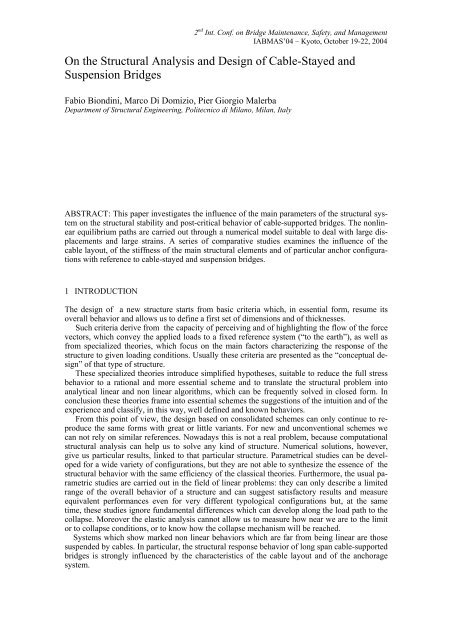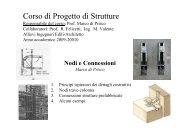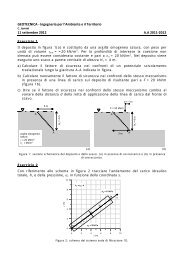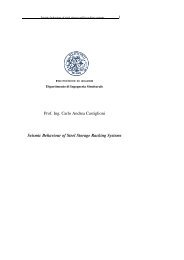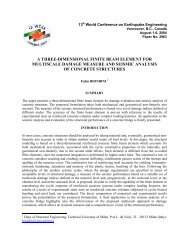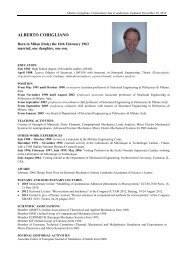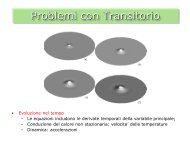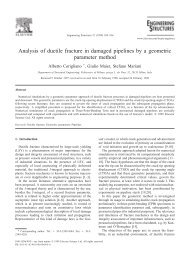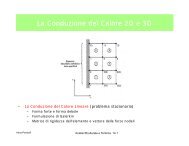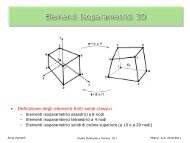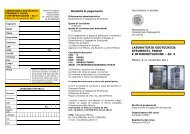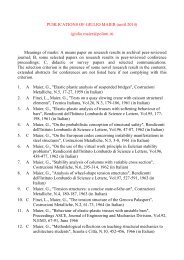On the Structural Analysis and Design of Cable-Stayed and ...
On the Structural Analysis and Design of Cable-Stayed and ...
On the Structural Analysis and Design of Cable-Stayed and ...
- No tags were found...
Create successful ePaper yourself
Turn your PDF publications into a flip-book with our unique Google optimized e-Paper software.
By taking into account <strong>the</strong> large amount <strong>of</strong> geometrical, topological <strong>and</strong> stiffness characteristicswhich influence <strong>the</strong> actual behavior <strong>of</strong> <strong>the</strong> bridge, a systematic structural analysis can becarried out only through non linear numerical methods.A numerical model suitable to deal with large displacements <strong>and</strong> large strains, typical <strong>of</strong><strong>the</strong>se system, has been developed. Through <strong>the</strong> principle <strong>of</strong> virtual works, developed accordingto <strong>the</strong> Updated Lagrangian formulation, a truss <strong>and</strong> a beam element have been introduced.The extension <strong>of</strong> such a formulation to complex structures gives a central role to <strong>the</strong> numericaltechniques for solving non linear problems in presence <strong>of</strong> singular points <strong>and</strong> <strong>of</strong> unstable behaviors.As known, <strong>the</strong> classical Newton-Raphson Method allows us to follow <strong>the</strong> equilibriumpaths working by load increments, but it is not able to follow post critical behaviors. In order toextend <strong>the</strong> analysis to <strong>the</strong> post critical field, <strong>the</strong> arc length method has been used. The methodhas been improved by specific procedures, able to detect <strong>the</strong> bifurcation points <strong>and</strong> <strong>the</strong> pathswhich depart from <strong>the</strong>se points. This numerical approach has been tested through many benchmarks.In this paper a series <strong>of</strong> comparative studies examines <strong>the</strong> influence <strong>of</strong> <strong>the</strong> cable layout, <strong>of</strong><strong>the</strong> stiffness <strong>of</strong> <strong>the</strong> main structural elements <strong>and</strong> <strong>of</strong> particular anchoring configurations with referenceto cable stayed <strong>and</strong> suspension bridges.2 CABLE-STAYED BRIDGESWe refer to <strong>the</strong> cable stayed bridge geometry shown in Figure 1, having <strong>the</strong> mechanical <strong>and</strong>geometrical characteristics listed in Table 1. In <strong>the</strong> same table <strong>the</strong> stay pretensioning is given. In<strong>the</strong> following, <strong>the</strong> influence <strong>of</strong> <strong>the</strong> cable layout on <strong>the</strong> overall bridge stability is investigated. Tothis aim, we intend to study <strong>the</strong> cases described in Table 2.PACC40m 21m 21mSEZ.4SEZ.3SEZ.21PP90m 200m 90m2 3 4 5 6 7 8 9 10 11 12 13 14 15 16 17 18 19 20 21 22 23 24(a) Earth AnchoredDeckStay(b) Semi Earth Anchored(c) Self AnchoredFigure 1. <strong>Structural</strong> model <strong>of</strong> <strong>the</strong> cable-stayed bridge.Table 1. Mechanical <strong>and</strong> cross-sectional properties, <strong>and</strong> pretensioning <strong>of</strong> <strong>the</strong> stays.Element E [GPa] I x [m 4 ] I y [m 4 ] A [m 2 ] w [kN/m]Deck 40 4.0896 236.09 8.0759 100Pylon(0-40m) 40 1.3482 13.843 5.00 –Pylon(40-61m) 40 0.722 2.7750 2.70 –Pylon(61-82m) 40 0.6219 2.6417 2.30 –Stay(1 e 2) 210 – – 0.01 –Stay(3,4,5,6) 210 – – 0.005 –Pretensioning <strong>of</strong> <strong>the</strong> staysStay 1≡24 2≡23 3≡22 4≡21 5≡20 6≡19P N0,i [kN] 4340 3480 2522 2219 1840 1590
Table 2. Case studied for cable stayed bridges.Model Description(a) Reference case: Fan shaped cable stayed bridge, with earth anchored lateral stays.(b) Model (a) with roller support at right end (semi-earth anchored system).(c) Model (a) with both ends roller supported. The lateral stays are anchored at <strong>the</strong> deck (selfanchoredsystem).0 Reference case: Fan shaped cable stayed bridge, semi-earth anchored.1-6 The stays, which in Model 0 converge to <strong>the</strong> top <strong>of</strong> <strong>the</strong> antennas, are no longer anchored allin one point but reach <strong>the</strong> antenna with variable distances within each o<strong>the</strong>r.7 Model 0, with stays having such a distance within each o<strong>the</strong>r as to reach <strong>the</strong> harp configuration.(d) Fan shaped cable stayed bridge, with self-anchored lateral stays <strong>and</strong> deck flexural stiffnessequal to a quarter <strong>of</strong> that <strong>of</strong> <strong>the</strong> starting Model 0.(e) Harp shaped cable stayed bridge, with self-anchored lateral stays <strong>and</strong> deck flexural stiffnessequal to a quarter <strong>of</strong> that <strong>of</strong> <strong>the</strong> starting Model 0.2.1 Comments on <strong>the</strong> behavior <strong>of</strong> (a), (b), (c) Models (Figure 2)The earth anchored Model (a) is stable <strong>and</strong> behaves like a typical tension hardening system. Theexternal cables (<strong>Cable</strong> 1 <strong>and</strong> <strong>Cable</strong> 24) constrain <strong>the</strong> heads <strong>of</strong> <strong>the</strong> antennas against longitudinaldisplacements <strong>and</strong> convey <strong>the</strong> horizontal components <strong>of</strong> <strong>the</strong> stay tension directly to <strong>the</strong> earth.Model (b) presents a limit point (λ = 15.73) caused by <strong>the</strong> instability <strong>of</strong> <strong>the</strong> right antenna,which is now free to move, while <strong>Cable</strong> 24 loads <strong>the</strong> deck, contributing to cause large longitudinal<strong>and</strong> vertical displacements.Model (c) has a limit point (λ = 15.48) which, in this particular case, is a bit higher than forModel (b), but it presents a worse post critical behavior without recovering stiffness after havingreached <strong>the</strong> limit point.30λ25λ=16.482015λ=15.7310(a) Earth Anchored System5(b) Semi Earth Anchored System(c) Self Anchored SystemV/L0-0,2 -0,18 -0,16 -0,14 -0,12 -0,1 -0,08 -0,06 -0,04 -0,02 0Figure 2. Live-load deflection path <strong>of</strong> cable-stayed bridges with different typology <strong>of</strong> supports.2.2 Comments on <strong>the</strong> behavior <strong>of</strong> 0 ÷ 7 Models (Figure 3)The sequence <strong>of</strong> Models 0-7 realizes <strong>the</strong> gradual development <strong>of</strong> stay geometry from pure Fanto a pure Harp configuration. For each <strong>of</strong> <strong>the</strong>se Models, Figure 3 shows <strong>the</strong> load deflection pathassociated to <strong>the</strong> vertical displacement at <strong>the</strong> middle <strong>of</strong> <strong>the</strong> central span.For Models 0-3 we have increasing limits points (λ = 15.73, 16.67, 18.24), with a certain tensionhardening post-critical branch <strong>and</strong>, for Model 1, a hint <strong>of</strong> snapback.For Models 5-7 <strong>the</strong>re are no limit points <strong>and</strong> <strong>the</strong> system appears stiffer than in <strong>the</strong> previouscases.
∆=0∆=4m04∆=1m∆=5m15∆=2m∆=6m26∆=3m∆=7m3756730λ252 3 4102015105V/L0-0,2 -0,18 -0,16 -0,14 -0,12 -0,1 -0,08 -0,06 -0,04 -0,02 0Figure 3. Evolution <strong>of</strong> <strong>the</strong> live load-displacement path with <strong>the</strong> variation <strong>of</strong> <strong>the</strong> configuration <strong>of</strong> <strong>the</strong>suspension system from <strong>the</strong> Fan to <strong>the</strong> Harp arrangement.2.3 Comments on <strong>the</strong> behavior <strong>of</strong> (d)-(e) Models (Figures 4 <strong>and</strong> 5)It must be remembered that <strong>the</strong> sequence <strong>of</strong> results shown in Figure 3 is specialized to a particularcombination <strong>of</strong> dimensions <strong>and</strong> <strong>of</strong> stiffness characteristics. From <strong>the</strong>se results, for instance,it appears that <strong>the</strong>re is always a limit point for those systems having <strong>the</strong> cables converging at <strong>the</strong>top <strong>of</strong> <strong>the</strong> antennas, while for Harp type systems <strong>the</strong> behavior appears to be stable <strong>and</strong> tensionhardening. This can be simply explained by observing that in <strong>the</strong> Fan case <strong>the</strong> stay action resultsin a concentrated force acting at <strong>the</strong> top <strong>of</strong> <strong>the</strong> antenna, while in <strong>the</strong> Harp system <strong>the</strong> verticalcomponents <strong>of</strong> <strong>the</strong> stay action are distributed along a certain height (Figure 4.a).In reality, for usual dimensions <strong>and</strong> stiffness distributions, is <strong>the</strong> Harp system <strong>the</strong> critical one.In fact, in a Fan system <strong>the</strong> applied load is transferred through <strong>the</strong> CB stay to <strong>the</strong> three BOD barsystem <strong>and</strong>, in this way, to <strong>the</strong> rigid supports (Figure 4.b). In <strong>the</strong> Harp system <strong>the</strong> applied loadacts directly on <strong>the</strong> CBAD system <strong>and</strong> it is transferred to <strong>the</strong> supports involving also <strong>the</strong> flexuralstiffness <strong>of</strong> <strong>the</strong> deck. Moreover in <strong>the</strong> Harp systems <strong>the</strong> stays have a lower vertical slope thanfor <strong>the</strong> Fan <strong>and</strong> this provokes a higher compression force in <strong>the</strong> deck. Figure 5 compares <strong>the</strong>load deflection path for <strong>the</strong> two cases (d-Fan) <strong>and</strong> (e-Harp).
FAN SystemHARP SystemB(a)BOACDA(b)DCFigure 4. Role <strong>of</strong> <strong>the</strong> suspension system in <strong>the</strong> structural stability <strong>of</strong> (a) <strong>the</strong> pylons <strong>and</strong> (b) <strong>the</strong> deck.O16λ14121086λ=5.294FANHARP2V/L0-0,1 -0,09 -0,08 -0,07 -0,06 -0,05 -0,04 -0,03 -0,02 -0,01 0Figure 5. Load deflection path <strong>of</strong> <strong>the</strong> Fan <strong>and</strong> Harp systems with low stiffness <strong>of</strong> <strong>the</strong> deck.3 SUSPENSION BRIDGESIn suspension bridges, <strong>the</strong> forces acting on <strong>the</strong> main cable, can be transferred to <strong>the</strong> earth directlythrough anchor blocks at <strong>the</strong> end <strong>of</strong> <strong>the</strong> side spans or can be self-contained by <strong>the</strong> longitudinalaction <strong>of</strong> <strong>the</strong> deck (self-anchored systems). The self-anchored systems do not require <strong>the</strong>volumes <strong>of</strong> <strong>the</strong> anchor blocks. <strong>On</strong> <strong>the</strong> o<strong>the</strong>r h<strong>and</strong> <strong>the</strong> stiffening girder, heavily compressed, willrequire a larger cross section.3.1 The case <strong>of</strong> <strong>the</strong> Great Belt BridgeThe present application refers to <strong>the</strong> basic dimensions <strong>of</strong> <strong>the</strong> Great Belt Bridge, shown in Figure6. The bridge has a central span length s c = 1624 m, two lateral spans lengths s l = 535m, height<strong>of</strong> <strong>the</strong> pylons h = (180+77.6) = 157.6 m, sag <strong>of</strong> <strong>the</strong> cable f =180 m. Based on such scheme, acomparative study has been carried out by varying some fundamental characteristics <strong>of</strong> <strong>the</strong>bridge. In particular, <strong>the</strong> cases listed in Table 3 have been examined.
535m1624m535m77,6 m180 mFigure 6. Great Belt Bridge. <strong>Structural</strong> scheme <strong>and</strong> basic dimensions.Table 3. Cases studied for suspension bridges.ModelDescription0 Real case: suspension bridge earth anchored (stable).1 The bridge <strong>of</strong> model 0, but self-anchored. (Area <strong>and</strong> Inertia <strong>of</strong> <strong>the</strong> deck are A=0.5m 2 ,J=1.66m 4 ).2 The bridge <strong>of</strong> Model 1 with increased deck stiffness (A = 0.9 m 2 , J = 3.32 m 4 ).3 The bridge <strong>of</strong> Model 1 with increased deck stiffness (A = 1.4 m 2 , J = 4.98 m 4 ).4 The bridge <strong>of</strong> Model 1 with height pylons increased from 257.6m to 277.6m, but maintaining<strong>the</strong> sag <strong>of</strong> <strong>the</strong> cable f = 180 m.5 The bridge <strong>of</strong> Model 4 with increased deck stiffness (A = 0.8 m 2 , J = 4.0 m 4 ).6 Equal to Model 1, but having a truss hanger net.7 Equal to Model 1, but with hangers having a variable slope along <strong>the</strong> side spans.8 Equal to Model 7 with increased deck stiffness (A = 0.8 m 2 , J = 3.32 m 4 ).The results are shown in Figure 7. The first diagram presents <strong>the</strong> values <strong>of</strong> <strong>the</strong> load multiplierat <strong>the</strong> limit point in function <strong>of</strong> <strong>the</strong> inertia <strong>of</strong> <strong>the</strong> deck. The little circles used to mark <strong>the</strong> limitpoints allow us to recognize if a limit point is stable or if it is followed by unstable branches.The main conclusions <strong>of</strong> <strong>the</strong>se comparative studies can be syn<strong>the</strong>sized as follows:– Suspended, earth anchored systems are generally stable.– The behavior <strong>of</strong> suspended, self-anchored systems is sensitive to <strong>the</strong> action <strong>of</strong> <strong>the</strong> deck <strong>and</strong>to <strong>the</strong> slackness <strong>of</strong> <strong>the</strong> hangers.Fur<strong>the</strong>rmore, for suspended, self-anchored systems we can observe that:– There are limit <strong>and</strong> bifurcation points which lead to post critical <strong>and</strong> generally unstable response,with snap back effects.– The limit load multiplier can be augmented by stiffening <strong>the</strong> deck. However, it must be keptin mind that <strong>the</strong> increase in weight causes an increase in <strong>the</strong> axial force, with <strong>the</strong> possibility<strong>of</strong> a critical behavior taking place in <strong>the</strong> pylons <strong>and</strong> not in <strong>the</strong> deck.– An increment <strong>of</strong> <strong>the</strong> pylon height involves a greater slope <strong>of</strong> <strong>the</strong> main cables: this involvethat a greater portion <strong>of</strong> <strong>the</strong> total force in <strong>the</strong> cables is conveyed directly to <strong>the</strong> earth through<strong>the</strong> bearings, while a lower fraction <strong>of</strong> this force contributes to <strong>the</strong> axial component in <strong>the</strong>deck. This brings to a higher value <strong>of</strong> <strong>the</strong> load multiplier.– The simultaneous increase <strong>of</strong> <strong>the</strong> deck inertia <strong>and</strong> <strong>of</strong> <strong>the</strong> pylons height do not produce relevantpositive effects, because <strong>the</strong> critical behavior depends on <strong>the</strong> pylons again, while <strong>the</strong>piers are higher <strong>and</strong> more stressed.– It is possible to obtain relevant increments in <strong>the</strong> limit load multiplier just by increasing <strong>the</strong>slope <strong>of</strong> <strong>the</strong> hangers in <strong>the</strong> lateral spans, without having any simultaneous increase in costsor in dead loads, as can be seen in models 7 <strong>and</strong> 8.3.2 The case <strong>of</strong> <strong>the</strong> Messina Strait BridgeA final example <strong>of</strong> application regards <strong>the</strong> influence <strong>of</strong> an elastic connection between <strong>the</strong> maincable <strong>and</strong> <strong>the</strong> anchor blocks <strong>of</strong> <strong>the</strong> Messina bridge. Figure 8 shows <strong>the</strong> model <strong>of</strong> <strong>the</strong> bridge. Figure9 shows a family <strong>of</strong> curves, corresponding to different stiffness <strong>of</strong> <strong>the</strong> elastic connection,which show how <strong>the</strong> vertical displacements <strong>of</strong> <strong>the</strong> point at <strong>the</strong> top <strong>of</strong> <strong>the</strong> anchorage lever dividedby <strong>the</strong> lever length (V/H), varies in function <strong>of</strong> a scalar multiplier λ <strong>of</strong> <strong>the</strong> uniform live load appliedto <strong>the</strong> deck.
λFOR MODEL 0 (REAL CASE EARTH ANCHORED)STABLE AND NEARLY LINEAR BEHAVIOR (λ =∞)15Ratio HPylons/LDeck=1:8λ=13.534I=1.66mA=0.5m 2MODEL 8λ=18.014I=3.32m2A=0.8mMODEL 4MODEL 7λ=12.994I=1.66mA=0.5m 2MODEL 2λ=12.414I=3.32mA=0.9m 2105MODEL 1λ=7.184I=1.66m2A=0.5mMODEL 6λ=7.744I=1.66mA=0.5m 2MODEL 5Ratio HPylons/LDeck=1:8λ=8.514I=4.0mA=0.8m 2MODEL 3λ=8.264I=4.98mStable Limit Point0Instable Limit PointA=1.4m 2 64Deck Stiffness I(m )01 2 3 4 58λ14λ712610Model 15432Model 286412V/L0-0.005 0 0.005 0.01 0.015 0.02v/L0-0.02 -0.01 0 0.01 0.02 0.03 0.04 0.05 0.06 0.07 0.0818λ16λ16141412Model 3121086Model 410864422V/L0-0.035 -0.03 -0.025 -0.02 -0.015 -0.01 -0.005 0 0.005v/L00 0.02 0.04 0.06 0.08 0.1 0.12 0.14 0.16 0.182018λ98λ167Model 514121086Model 665434221v/L0-0.18 -0.16 -0.14 -0.12 -0.1 -0.08 -0.06 -0.04 -0.02 0v/L00 0.02 0.04 0.06 0.08 0.1 0.12 0.14 0.16 0.1814λ20λ1812161014Model 7864Model 812108624v/L00 0.02 0.04 0.06 0.08 0.1 0.12 0.14 0.16 0.182v/L00 0.05 0.1 0.15 0.2 0.25Figure 7. Great Belt Bridge. Live load-displacement paths for <strong>the</strong> models 1-8 described in Table 3.
20.00m777m 183m3300m183m 627m300m358mHangerMain <strong>Cable</strong>RigidConnectionDeckPylon4.80mPylonMain <strong>Cable</strong>SupportAnchorSystemFigure 8. <strong>Structural</strong> Model <strong>of</strong> <strong>the</strong> Messina Strait Bridge.21V0250λk2001502Rigid ElementK=100x10^3 MN/mK=10x10^3 MN/mK=5x10^3 MN/mK=2.5x10^3 MN/mK=1x10^3 MN/mK=0.75x10^3 MN/mK=0.5x10^3 MN/m100501-0,35 -0,3 -0,25 -0,2 -0,15 -0,1 -0,05 0 0,05 0,1Figure 9. Messina Strait Bridge. Live load-displacement paths with respect to <strong>the</strong> ratio between <strong>the</strong> verticaldisplacement V <strong>of</strong> <strong>the</strong> point at <strong>the</strong> top <strong>of</strong> <strong>the</strong> anchorage lever <strong>and</strong> its height H (V/H).0V/H4 CONCLUSIONSThe role played by <strong>the</strong> main parameters <strong>of</strong> <strong>the</strong> structural system in driving <strong>the</strong> structural stability<strong>and</strong> post-critical behavior <strong>of</strong> cable-supported bridges has been investigated. In particular, a parametricstudy based on a numerical model suitable to deal with large displacements <strong>and</strong> largestrains has been carried out. The results <strong>of</strong> this study allow to highlight <strong>and</strong> quantify <strong>the</strong> highsensitivity <strong>of</strong> <strong>the</strong> structural response <strong>of</strong> cable-stayed <strong>and</strong> suspension bridge with respect to <strong>the</strong>characteristics <strong>of</strong> both <strong>the</strong> suspension <strong>and</strong> anchorage systems.5 REFERENCESBonet J., Wood, R., 1977. Nonlinear continuum mechanics for finite element analysis. Cambridge UniversityPress.Bontempi, F., Malerba, P.G., 1996. The control <strong>of</strong> <strong>the</strong> tangent formulation in structural non linear problems,Studies <strong>and</strong> Researches, 17, Graduate School for Concrete Structures, Politecnico di Milano,Milan, Italy (in Italian).Bontempi, F., Malerba, P.G., 1997. The Role <strong>of</strong> S<strong>of</strong>tening in <strong>the</strong> Numerical Nonliner <strong>Analysis</strong> <strong>of</strong> ReinforcedConcrete Frames, <strong>Structural</strong> Engineering <strong>and</strong> Mechanics, 5(6), 785-801.Crisfield, M.A., 1991. Non-linear finite element analysis <strong>of</strong> solids <strong>and</strong> structures, John Wiley & Sons.Di Domizio, M., 2003. Geometrical non linear analysis <strong>of</strong> cable stayed <strong>and</strong> suspension structures. Dissertation,Politecnico di Milano, Milan, Italy (in Italian).Gimsing, N., J., 1988. <strong>Cable</strong> supported bridges, John Wiley & Sons.Riks, E., 1979. An incremental approach to <strong>the</strong> solution <strong>of</strong> snapping <strong>and</strong> buckling problems, InternationalJournal <strong>of</strong> Solids Structures. 15, 529-551.


